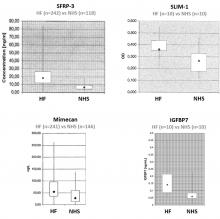BACKGROUND
Heart failure (HF) is one of the most prevalent, costly and life-threatening diseases in developed countries. Early diagnosis of this disease is a challenge as decline in the cardiac output does not occur until the later stages of HF due to certain compensatory mechanisms. Thus, biomarkers are useful in supplementing information from the detection of physical or structural abnormalities by various techniques (e.g. echocardiogram). Natriuretic peptides (particularly NT-proBNP), cardiac troponin, and markers of inflammation are all used in the clinic, though none of them is diagnostic with 100% specificity and 100% sensitivity. New biomarkers, individually or in a panel, can thus improve the current standard of diagnosis or prognosis of HF.
TECHNOLOGY
Researchers of the University of Toronto have discovered a series of markers present in the circulation (i.e. serum, plasma, blood) that are indicative of heart failure. These include the following proteins: secreted frizzled related protein 3 (SFRP-3), four and a half LIM domain-1 (SLIM-1), Nogo-C, mimecan, and the insulin like growth factor binding protein 7 (IGFBP-7). These markers have been tested in human samples of patients with and without heart failure to ascertain the diagnostic potential (Figure 1).
COMPETITIVE ADVANTAGE
- Improved diagnosis and prognosis of heart failure
- Easily accessible biomarkers (present in the circulation)
APPLICATIONS
- Heart failure diagnosis and prognosis
- Staging of heart failure
- Risk of disease progression
- Guidance for therapy selection
- Evaluation of the time-course of disease
INTELLECTUAL PROPERTY STATUS
- Granted patents / applications
- SFRP-3 CA, EP, ES, JP, US WO2009132815A1
- Slim-1 CA, EP, ES, US WO2008107201A1
- Mimecan CA, CN, EP, ES, HK, JP, US WO2011012268A1
- IGFBP-7 CA, CN, DK, EP, ES, PL US WO2008089994A1
- Nogo-C EP, DE, ES EP1967853A1
PROJECT STATUS
Proteomic studies of the heart from two mice models were used to identify HF biomarkers. The first model was a transgenic R9C mouse model of dilated cardiomyopathy, while the second was a mouse model where pressure-overload caused by aortic banding (AB) induces cardiac-hypertrophy and heart failure. Immunoassays (ELISAs) were then used to assess the elevated levels of biomarkers in human serum samples (Figure 1).
Figure 1. Elevated biomarker presence is observed in sera from patient populations with heart failure (HF) compared to those with normal human sera (NHS). Patient population sizes are above the graphs.





